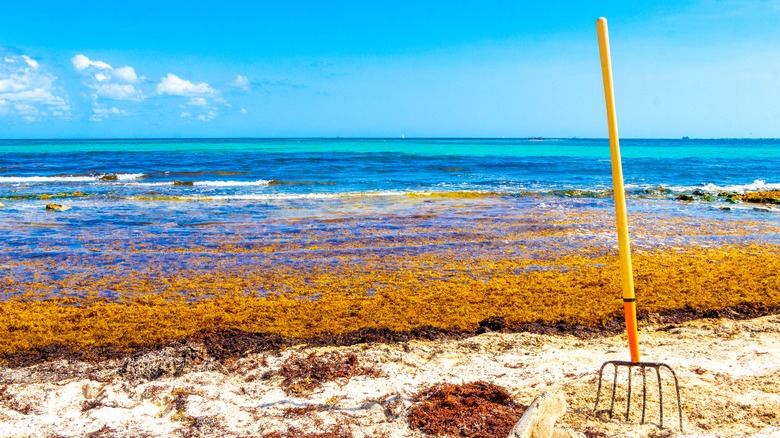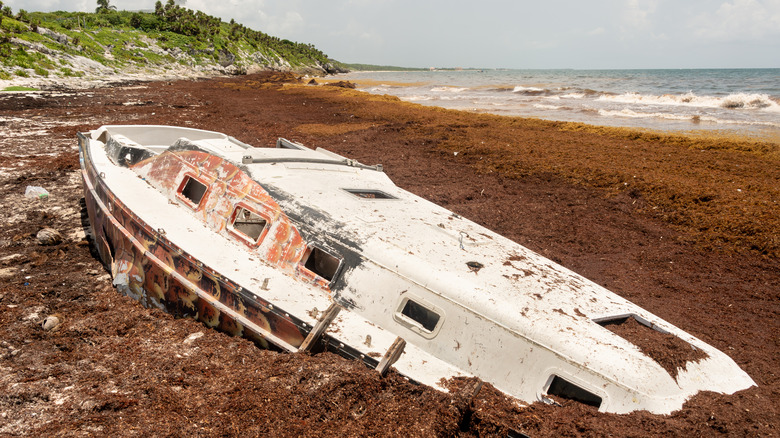How To Avoid This Pesky Problem That Overtakes Some Of Mexico's Most Popular Beaches
Mexico's shimmering coastlines, with their golden sands and azure waters, are a magnet for tourists from around the world. However, a persistent and pesky problem threatens the beauty of these idyllic shores: sargassum. This seaweed is washing up in large quantities, affecting the aesthetic appeal of the beaches, the comfort of visitors, and much more. Understanding sargassum, its impacts, and how to avoid its inconveniences is essential for anyone planning a vacation to Mexico's beaches.
Sargassum is a type of brown seaweed that is found in large quantities in the Sargasso Sea, a region in the Atlantic Ocean. Unlike other seaweeds, sargassum stays afloat on the ocean's surface, creating vast, thick mats. Also called the "ocean's golden forest," sargassum serves as a habitat, food, and breeding ground for 100+ species of invertebrates, 100+ species of fish, and four types of turtles. While it plays a crucial role for animals in the marine ecosystem, for humans, its arrival on beaches in large quantities leads to unsightly landscapes and hindered beach access.
Nearly every east-facing beach in Mexico, particularly in Quintana Roo, is afflicted with sargassum. Some beaches get much more sargassum than others, particularly in Tulum, Cancun, Puerto del Morelos, Playa del Carmen, and the east coast of Cozumel. West-facing beaches, such as those on Isla Mujeres, Isla Contoy, Punta Mosquito, and the west coast of Cozumel, get little to no sargassum. Sargassum arrives in seasons, typically hitting its peak from April to August. However, its uninvited appearance in Mexico has become more frequent and unpredictable.
Environmental and economic effects of sargassum
The phenomenon of sargassum is influenced by factors such as climate change, run-off from pollution, and changing ocean temperatures. In recent years, the seaweed blooms have become more frequent and alarming, especially after the year 2011. According to a 2019 report, NASA satellite data indicated that the sargassum belt has grown into a 5,500-mile-long stretch weighing 20 million metric tons.
The environmental effects of sargassum are far-reaching. When it piles on the beach, it prevents sea turtles from laying eggs safely and hatchlings from reaching the ocean. It caries invasive species and harms native species such as flying fish and mahi-mahi. It also blocks coral reefs from receiving sunlight. When it decomposes at sea, it contaminates the water with harmful bacteria. When sargassum washes ashore, it releases hydrogen sulfide, which smells like rotten eggs and can cause health issues, especially for those with respiratory problems. Whether at sea or on the beach, sargassum is a problem that is only getting worse.
Economically, it's wreaking havoc. Tourism makes up 87% of Quintana Roo's GDP, and during the multi-month sargassum season, hotel occupancy rates decline — trouble for anyone who depends on tourism for their livelihood. Moreover, beachfront hotels have to pay between $70,000 and $90,000 per month for sargassum removal. Even the Navy has gotten involved to help! The government of Tulum has taken precautions to keep it tourist-friendly by dispatching more costly anti-sargassum vehicles, removal equipment, and at-sea barrier systems in a containment plan called "Tulum Against Sargassum."
Dealing with sargassum in Mexico
While it may seem daunting, there are ways to avoid sargassum during your visit to Mexico. Before planning your trip, research the current sargassum situation on the beaches you intend to visit. There are websites such as Sargassum Monitoring and social media groups like Sargassum Seaweed Updates on Facebook dedicated to monitoring sargassum levels in real-time.
Choose your travel time wisely and avoid the sargassum season between April and August. Although it's becoming a year-round nuisance, planning your visit outside these months can significantly reduce the likelihood of encountering nasty seaweed on the beaches. Choose your travel location wisely and avoid the Caribbean side of Mexico. Opt for destinations that have historically experienced less seaweed accumulation, such as beaches on the west coast in Los Cabos or Puerto Vallarta.
If you are visiting during the sargassum season, be prepared to adapt your plans. Explore inland attractions or visit seaweed-free beaches recommended by locals. Mexico also offers a plethora of attractions beyond its shores. Consider exploring ancient ruins, vibrant cities, lush jungles, and stunning cenotes as alternatives to beach days.
Luckily, humans have gotten inventive with ways to upcycle sargassum into useful products such as vegan fabric, agricultural fertilizer, and skincare. Because sargassum generates ethanol, it is also being examined as a potential biofuel. It even has healing properties and has been used in Chinese traditional medicine since the 8th century. You can also eat it (if you dare).


